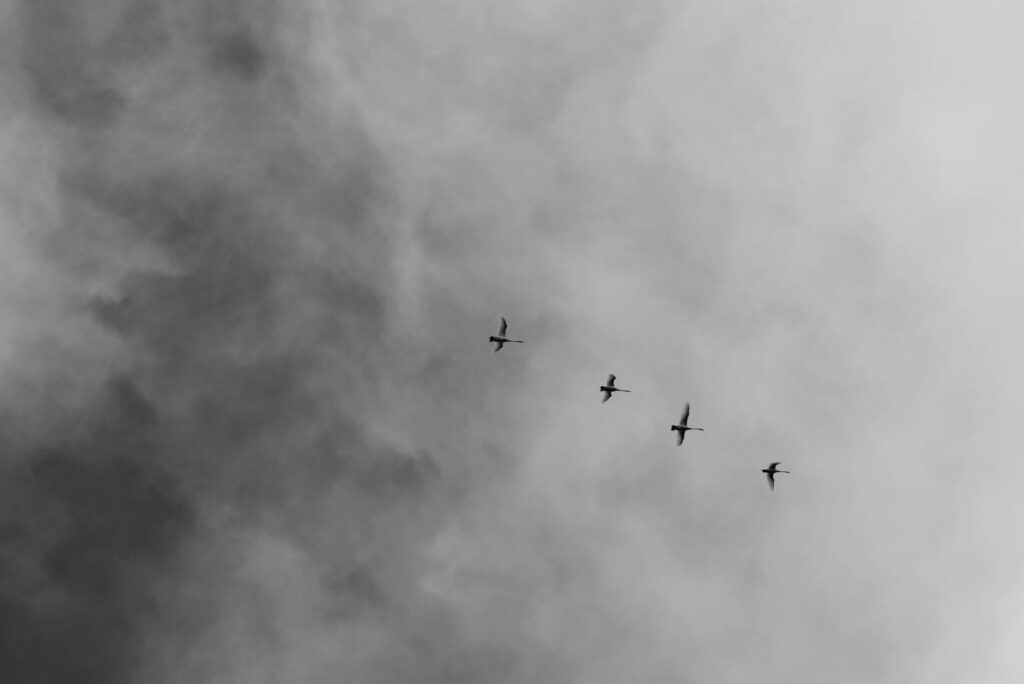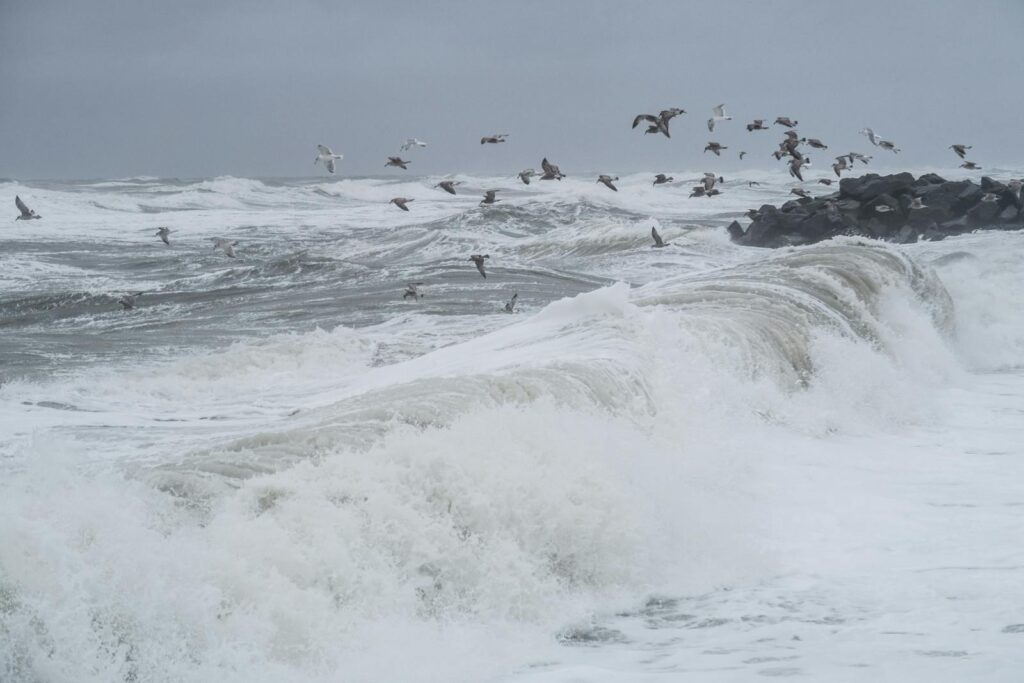Long before meteorologists developed sophisticated technology to predict weather patterns, birds have been demonstrating an uncanny ability to sense approaching storms. This remarkable capacity isn’t just fascinating, it’s a testament to the evolutionary adaptations that have helped birds survive for millions of years. From seabirds that navigate around hurricanes to songbirds that alter their behaviour hours before a storm hits your backyard, these feathered forecasters possess a sophisticated array of biological tools that help them detect changes in their environment. In this article, we’ll explore the fascinating mechanisms that allow birds to detect storms before they happen and how these adaptations have shaped their behaviour, migration patterns, and survival strategies across different species and environments.
The Barometric Pressure Connection

Birds possess a remarkable sensitivity to changes in barometric pressure, one of the most reliable indicators of approaching weather systems. The air-filled cavities in birds’ bodies, particularly their specialised air sacs that complement their lungs, make them extremely responsive to pressure fluctuations. When barometric pressure begins to drop—a telltale sign of an approaching storm—birds can detect these changes well before humans notice any difference. This sensitivity evolved as a survival mechanism, allowing birds to seek shelter or alter their flight plans before dangerous weather conditions develop. Research has shown that some species can detect pressure changes as small as 0.01 atmospheres, equivalent to the pressure difference between ground level and approximately 100 feet of elevation.
Infrasound Detection Capabilities

Birds possess the remarkable ability to hear infrasound—sound waves at frequencies below the human hearing threshold of 20 Hz. These low-frequency sounds can travel thousands of miles through the atmosphere and are naturally produced by weather events like thunderstorms, hurricanes, and even distant ocean waves. Some researchers believe birds can detect these storm-generated infrasounds days before the weather system arrives in their vicinity. This adaptation is particularly evident in migratory species that must make critical decisions about when to begin or delay their journeys based on distant weather conditions. The avian ear structure, which differs significantly from mammals, contains specialised receptors that can register these subtle atmospheric vibrations and translate them into meaningful information about approaching weather systems.
Electromagnetic Sensitivity

One of the most fascinating abilities in certain bird species is their sensitivity to the Earth’s electromagnetic field and its fluctuations. Birds possess specialised cells containing magnetite—a naturally magnetic mineral—primarily located in their beaks and eyes, which allows them to detect subtle changes in electromagnetic patterns. Before storms, atmospheric electromagnetic conditions often shift due to ionisation changes and lightning activity, providing birds with another early warning system. This sensitivity helps explain why birds often vanish from an area shortly before significant electrical storms arrive. Research with homing pigeons has demonstrated that their navigation abilities can be disrupted by electromagnetic anomalies, further confirming the importance of this sense in their environmental awareness.
The Role of Specialised Feathers

Bird feathers serve as sophisticated environmental sensors beyond their obvious functions in flight and insulation. The intricate microstructure of feathers allows them to respond to changes in humidity and air density, both critical factors that shift before storms. Some birds possess specialised rictal bristles—modified feathers around their beaks—that may enhance their ability to detect air movement patterns and pressure changes. Aquatic birds like ducks and geese have water-repellent feathers that may become increasingly sensitive to moisture changes as storm systems approach, triggering behavioural changes. Researchers have observed that many species engage in intensive preening behaviours before storms, potentially redistributing protective oils and preparing their feathers for challenging weather conditions.
Behavioural Changes Before Storms

As storms approach, birds exhibit distinct behavioural changes that serve as reliable indicators for human observers. Many species display increased feeding activity, consuming more food than usual to build energy reserves in anticipation of potential food scarcity during and after the storm. Flocking behaviour often intensifies, with birds gathering in larger groups and showing greater coordination in their movements. Vocalisation patterns frequently change, with some species becoming notably quieter while others increase their calls in specific patterns that differ from their normal communication. These behavioural shifts occur in a predictable sequence, with subtle changes beginning up to 24 hours before human-detectable weather changes, and more dramatic alterations in behaviour appearing as the storm draws nearer.
Migration Timing and Storm Prediction

Migratory birds demonstrate perhaps the most impressive weather prediction abilities, as they must make critical decisions about when to begin their often thousands-of-miles-long journeys. Studies tracking migratory flocks have shown that birds will often delay departures when storms lie along their intended route, even when local conditions appear favourable. This suggests their ability to sense distant weather systems that would impact their journey. Some species, like bar-tailed godwits that fly non-stop over the Pacific Ocean, must make especially accurate predictions, as they have no opportunity to land during their 7,000-mile migrations. Remarkably, radar studies have documented massive “fallouts” where thousands of birds suddenly descend to take shelter just hours before severe weather strikes, demonstrating their collective storm-detection capabilities even amid migration.
Seabirds: The Ultimate Storm Detectors

Seabirds have evolved particularly acute storm detection abilities, as their survival depends on navigating the unpredictable marine environment. Species like petrels, albatrosses, and frigatebirds can detect tropical storms and hurricanes days before they fully form, allowing them to navigate around these dangerous systems. Some seabirds, like storm petrels, actually use storm fronts to their advantage, riding the powerful updrafts to travel efficiently while expending minimal energy. Their specialised nasal passages can detect minute changes in air and water chemistry that precede major storm systems. Most remarkably, tracked frigatebirds have been observed making dramatic course changes up to 200 miles from developing hurricane systems, demonstrating an awareness of weather patterns that extends far beyond human unaided perception.
The Biology Behind Avian Storm Detection

The biological mechanisms underlying birds’ storm detection abilities involve complex interactions between their nervous systems and specialised sensory organs. Their inner ear structure contains the paratympanic organ, which functions similarly to a barometer by responding to pressure changes. Birds also possess a highly developed vestibular system that helps them maintain balance during flight, but also provides sensitivity to air pressure and density shifts. Many species have a higher density of pain receptors in their feet and legs, which may respond to atmospheric pressure changes similar to how humans with arthritis report discomfort before storms. Additionally, the avian respiratory system, which is more efficient and complex than mammals, includes air sacs throughout their bodies that make them essentially living barometers.
Regional and Species-Specific Adaptations

Birds’ storm detection abilities vary significantly based on their native habitats and evolutionary history. Species from regions with frequent, severe weather events typically display more sophisticated prediction behaviours than those from more stable climates. Coastal birds like gulls and terns often begin moving inland 48-72 hours before hurricanes make landfall, while desert-dwelling species show heightened sensitivity to distant thunderstorms that might bring rare rainfall. Prairie chickens and other grassland birds have been observed gathering in unusual formations before tornadoes develop in the American Midwest. Perhaps most remarkably, certain rainforest species in the Amazon can detect approaching rainfall with such precision that indigenous peoples have traditionally relied on their behavioural changes as weather indicators for agricultural planning.
The Science of Studying Avian Storm Prediction

Scientists use increasingly sophisticated methods to study and document birds’ weather prediction abilities. Modern research employs GPS tracking devices weighing less than a gram that can record birds’ movements about developing weather systems with unprecedented precision. Wind tunnel experiments allow researchers to measure birds’ responses to controlled pressure changes in laboratory settings, confirming their sensitivity to pre-storm conditions. Acoustic monitoring stations record changes in bird vocalisations before, during, and after storms, revealing patterns that correspond to approaching weather fronts. Perhaps most fascinating is the emerging field of comparative neurobiology, where researchers examine the neural pathways that process environmental data in birds’ brains, helping explain how they integrate multiple sensory inputs into accurate weather predictions.
Implications for Bird Conservation

Birds’ storm detection abilities have significant implications for their conservation in our changing climate. As weather patterns become more volatile and extreme, some species may face challenges if storms develop too rapidly for their traditional detection mechanisms to provide adequate warning. Habitat fragmentation compounds this threat by limiting the available shelter options when birds detect approaching storms. Artificial light pollution can disrupt the electromagnetic sensing abilities some birds rely on for storm detection, potentially leaving them vulnerable to severe weather. Conservation strategies increasingly incorporate protected stopover sites along migration routes specifically designed to provide emergency shelter during unpredictable weather events, acknowledging the critical importance of supporting birds’ natural storm avoidance behaviours.
What Humans Can Learn from Avian Meteorologists

The sophisticated weather detection abilities of birds offer valuable insights for human weather prediction and biomimetic technology development. Scientists are studying how birds integrate multiple environmental cues to create accurate short-term forecasts, hoping to improve our prediction models for severe weather events. Some coastal communities already informally incorporate bird behaviour into their hurricane preparedness decisions, noting when seabirds suddenly disappear from shorelines. Engineers developing sensitive atmospheric monitoring equipment have drawn inspiration from the structure of bird feathers and their response to humidity and pressure changes. Perhaps most promising is research into how birds’ collective intelligence amplifies their sensing abilities, offering models for distributed sensor networks that could revolutionise how we monitor and predict dangerous weather patterns.
Conclusion

Birds’ remarkable ability to detect storms before they happen represents one of nature’s most sophisticated early warning systems. Through a combination of barometric pressure sensitivity, infrasound detection, electromagnetic perception, specialised feathers, and collective intelligence, birds have evolved an impressive toolkit for weather prediction that often surpasses our technological capabilities. These adaptations highlight the extraordinary ways evolution has equipped birds to survive in dynamic environments for millions of years. As we face increasingly unpredictable weather patterns due to climate change, understanding and preserving these avian forecasters becomes not just a matter of scientific curiosity but potentially a valuable resource for improving our relationship with our changing environment. The next time you notice birds behaving unusually in your backyard, pay attention—they might be telling you something important about the weather to come.
